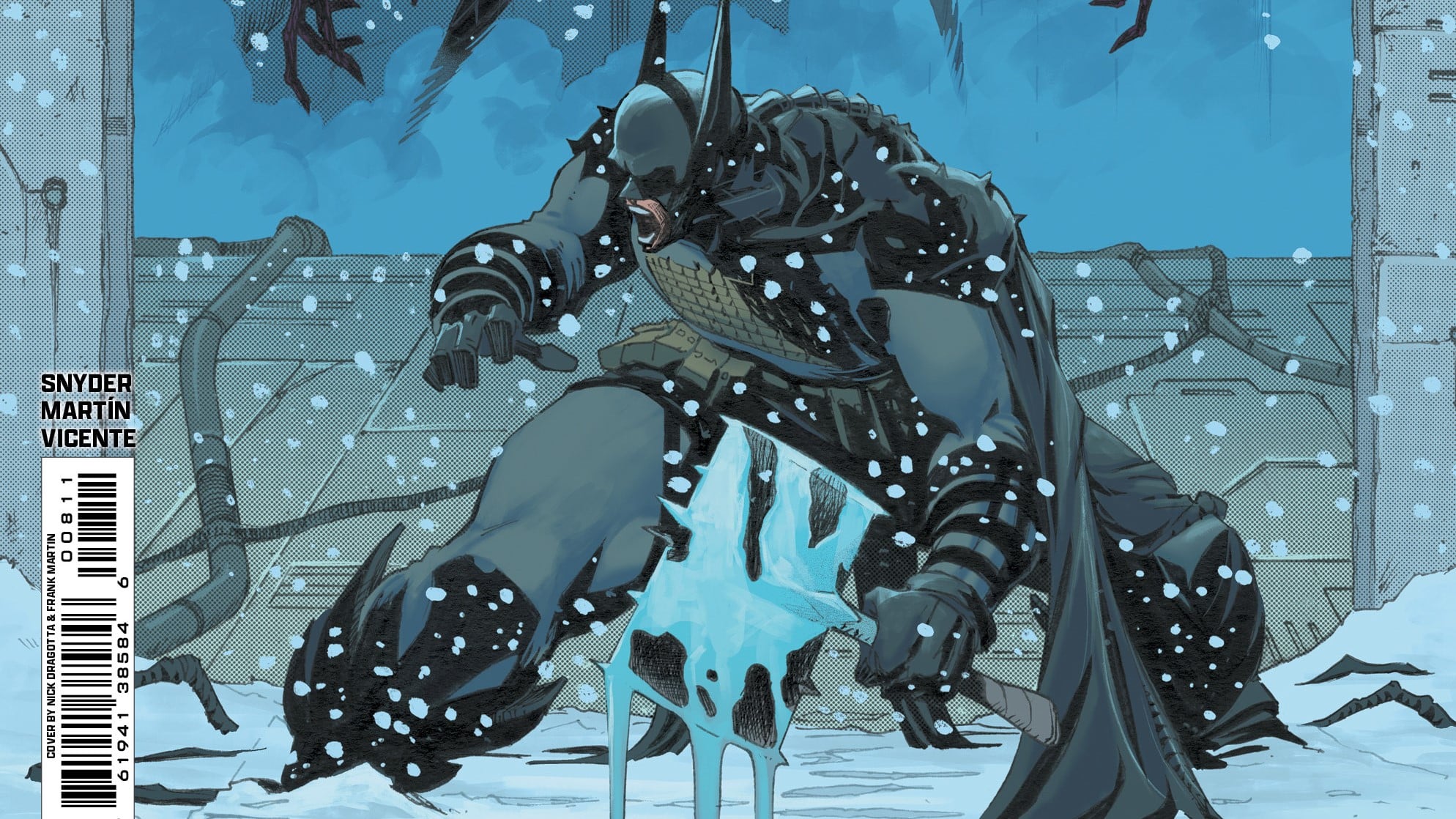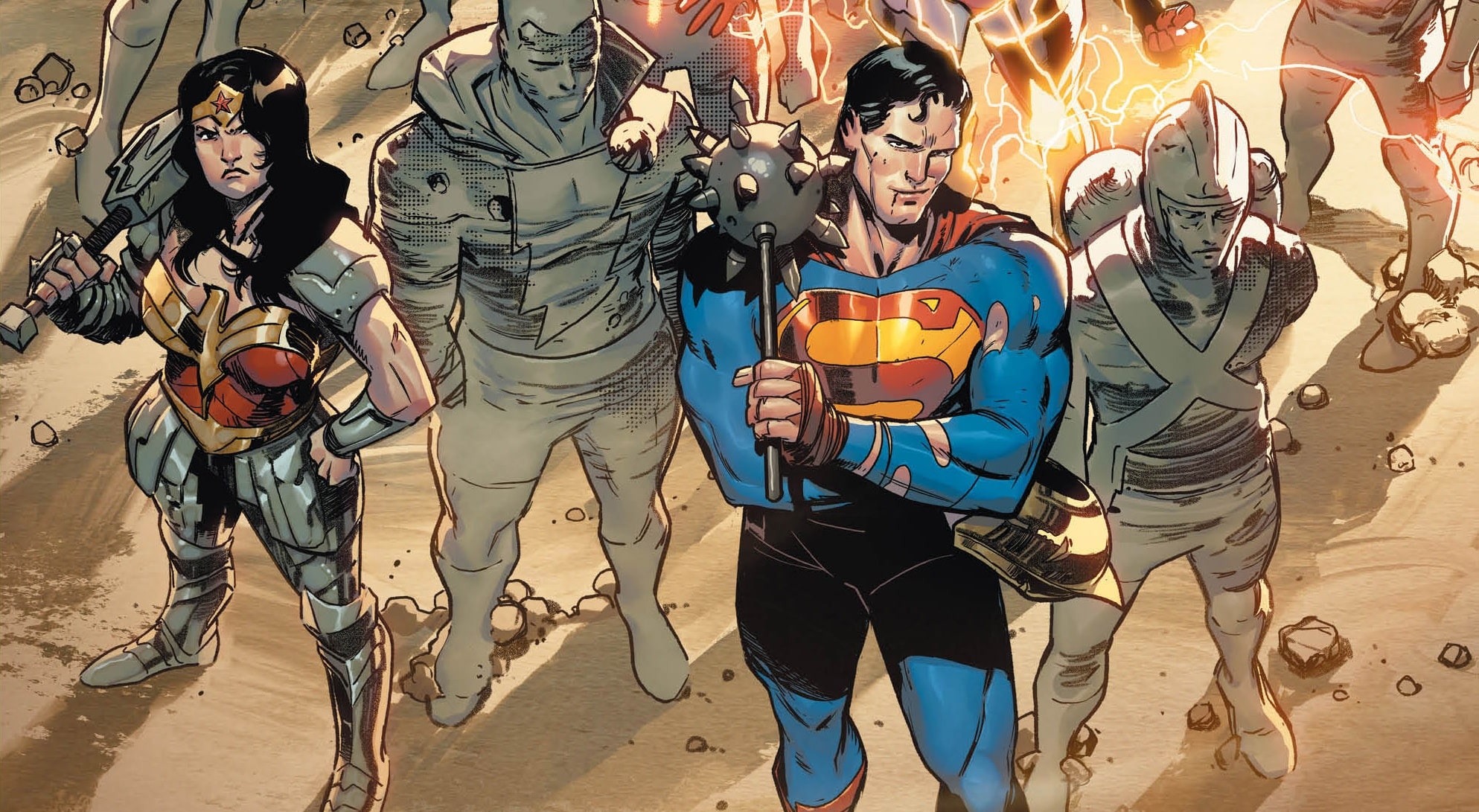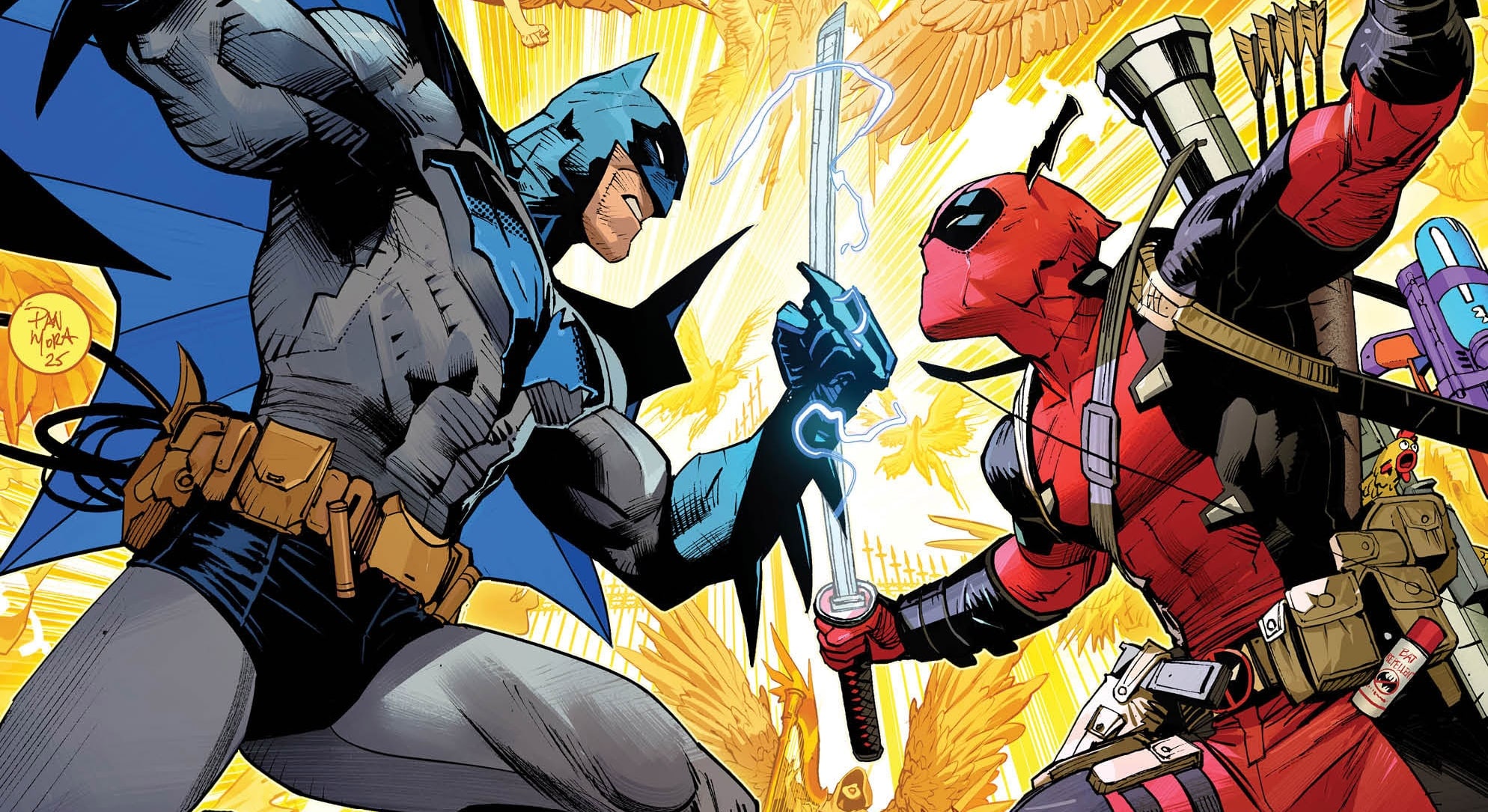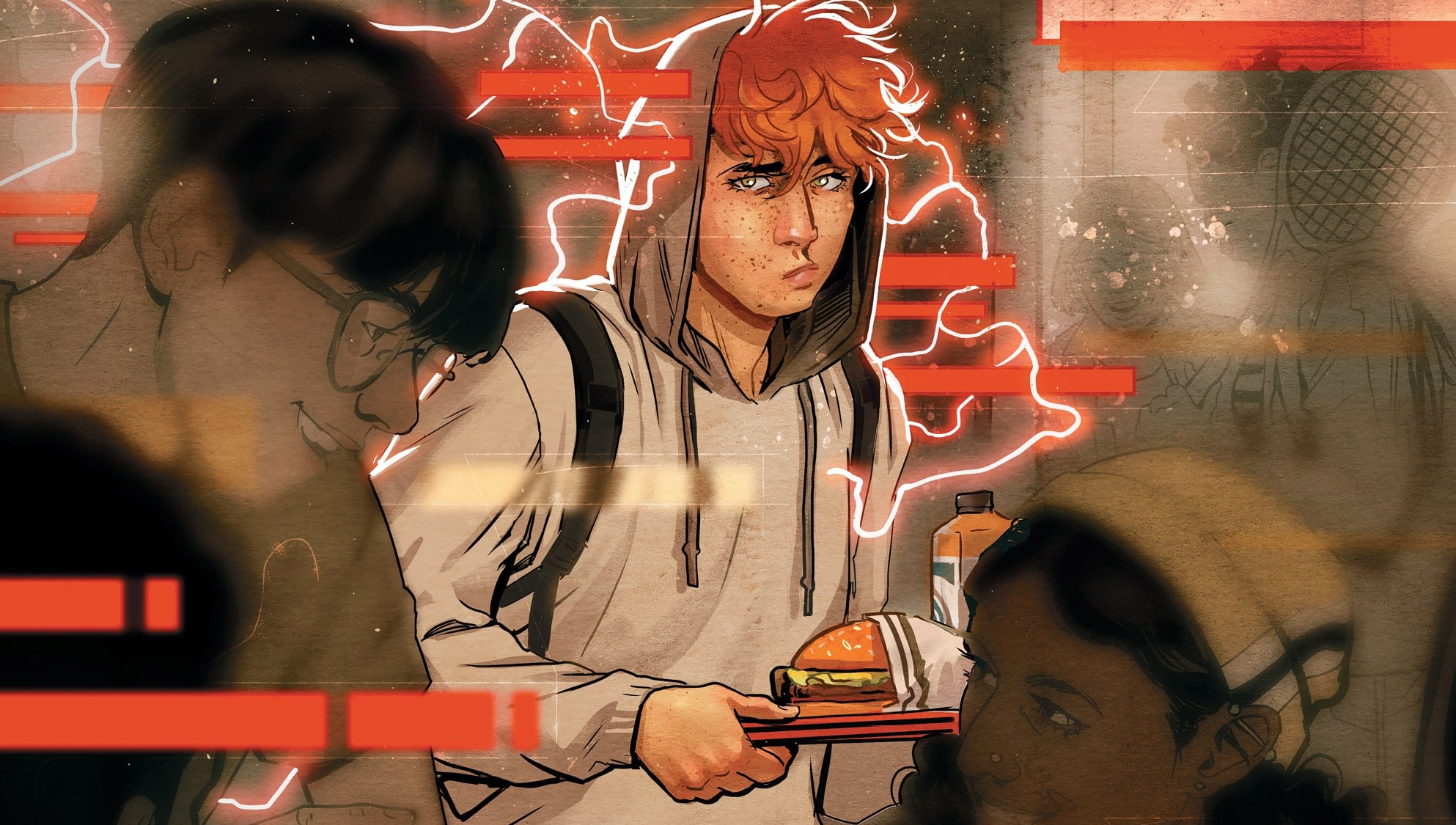Welcome back to Talking Absolute…, where we focus on the storylines, controversies and themes that have captured our imaginations in the Absolute DC titles each month. Today, we’ll be covering the first half of May and three new issues. Guest artists, surprising alternate origin stories, villains in starring roles: Absolute DC has sprung some surprises in May so far. Let’s dig in.
Absolute Green Lantern #2
Written by Al Ewing, drawn and colored by Jahnoy Lindsay and lettered by Lucas Gattoni.

When it comes to horror movies, acts one and two outweigh the third in entertainment value, narrative coherence and quality almost every single time. The very few, and I mean very few, that have an ending that pays off the jump scares, the creepy mystery and can suspend the belief that the protagonist wouldn’t just get the hell out of dodge within the first five minutes are worth their weight in gold. But it’s always about the journey, rarely about the destination. A movie that can make you believe that you’re in for a mind-blowing revelation should still be relished because we must, if nothing else, live in hope.
This is where I’m at with Absolute Green Lantern. After needing a second issue to feel my way around what Al Ewing and Jahnoy Lindsay were trying to accomplish with this series, I’m reveling in the potential of this dark, twisted Green Lantern lore. Issue #2, which is centred on Abin Sur’s fateful journey to and brutal judgment of Evergreen, Nevada, places Hal Jordan and lifelong friend Jo Mullein on a path toward inevitable conflict. Newly imbued with the power of a Green Lantern, she encounters a Hal Jordan entirely changed by his new condition: a black hand that visits death upon all who threaten it. Ewing builds the eerie tension in this scene by cutting between present and past, adding further context and clarity to the horrors delivered by Abin Sur. It’s clear as the scene progresses that the forces that possess Hal and Jo are cosmically and existentially incompatible with one another, which is made terrifying by the change Hal undergoes as it develops. The cut back to the present where it’s clear Jo senses Hal’s potential threat in particular is chilling.
Lindsay’s art ramps up the sense of the uncanny, primarily through the increasing levels of mania on Hal’s face as the Black Hand takes hold. Equally impressive is his rendering of Abin Sur as a figure of terror. The way Lindsay frames his statuesque figure, his perspective cast downward in judgment of humanity, and captures his cold, unfeeling judgment is terrifying. Ewing has always been good at writing mercurial villains and the natural narrative tension they create, of which Abin Sur is a great example. Ewing establishes the cultural disconnect early in the scene, using the precariousness of linguistic meaning to obscure exactly what it is Abin Sur is saying to Evergreen’s assembled welcome party. This makes Guy Gardner’s death a huge shock, and turns the atmosphere of the scene on a dime instantly.
The aspect that excites me most about this series after issue #2 is villainous Hal Jordan. While it’s clear he’s been infected in some capacity, there are moments where the line between the two blur. To what extent is it superseding the man who existed before, and to what extent is it simply accentuating the characteristics that were already there? Given what we know about Hal, a man possessed of pride and ego, is the Black Hand simply a justification of his self-aggrandizing sense of cosmic purpose? His encounter with Abin Sur had a sense of prophetic destiny to it that is fascinating. Revealing the origin of his, Jo’s and John Stewart’s powers could be this series’ make or break. For now, I’m cool not knowing. I think I’ll just let the mystery be.
Buy Absolute Green Lantern #2 here.
Absolute Superman #7
Written by Jason Aaron, drawn by Carmine Di Giandomenico, colored by Ulises Arreola and lettered by Becca Carey.

Absolute Superman has been very hit and miss for me so far. After a first four issues in which I thought Aaron and Rafa Sandoval built a compelling Krypton on the back of a solid allegory about class and climate change, it came crashing down to Earth along with Kal in issues #5 and #6. Plots about Lois Lane, Jimmy Olsen and the Kents, which were all setting up a wider plot about the Lazarus Corp, fell a bit flat and felt like an uninspiring cover band doing a greatest hits set. The reveal of Ra’s al Ghul running the show was pretty predictable given the name, and Brainiac felt like little more than a tech solution to drive the plot.
Until now.
Everyone loves an underdog story, right? It’s one of the pillars on which the superhero genre was built, even if the foundations are a little shaky (see a certain orphan with unimaginable riches, or a dorky high schooler with unexplainable levels of rizz). Surely the most heroic route to the top must start from the very bottom, from zero, from the scrap heap of human existence, right? You’re goddamn right it does. Heroes aren’t born, they’re made. In some cases they’re the 419,732nd attempt. Such is the case of Absolute Brainiac.
It’s worth noting that Absolute Superman #7 is a Superman comic without Superman, which is always significant. Having an entire issue focused on your villain’s origin is a simple but effective way of adding depth to your villain. Aaron’s scripting here is great because it gives Brainiac not just a functional motivation but a pathological one. The issue builds through this Brainiac’s rise through the ranks of other Brainiacs, going from garbage disposal man to the head of the whole network, and firmly connects his entire outlook on evolving beyond his position and function. This issue not only establishes his credibility as a threat to Superman but also to Ra’s. Di Giandomenico’s art captures the gore and chaos that exists within the rigid hierarchical network structure by flitting between busy, heavy inks to a cleaner and more orderly linear structure, which characterizes Brainiac as a volatile and dangerous virus in a network, one that could erode the very foundations of the world Superman is pledged to protect and the organization tearing it apart.
Buy Absolute Superman #7 here.
Absolute Batman #8
Written by Scott Snyder, drawn by Marcos Martín, colored by Muntsa Vicente and lettered by Clayton Cowles.

ComicsXF has some of the most comprehensive coverage of Batman you’ll find anywhere on the web, so read BatChat for a detailed review of Absolute Batman #7, which saw the introduction of this elseworld’s Mr. Freeze.
I’ve been thinking a lot about Matt and Will’s take on this series so far, and want to build on it here.
“Matt: I think Snyder is fed up with the world we live in, and who isn’t, but isn’t willing to give up on it. That is what we saw in that first arc, for sure. This Gotham is corrupt and broken beyond measure, but Batman keeps fighting. It’s sort of a central Batman tenet, but Prime Earth Batman lives in a world that might actually embrace the whole phrase and not just the second part.
“Will: I can buy that as a thesis, but Synder needs to do more to show his work. Like, in this issue, Gotham is under martial law, but it’s barely a passing background note. That needs to be investigated a bit more, especially with a Bruce who seems to just shrug at possible stepdad Jim Gordon’s election loss.”
Here’s my two Alfred pennies’ worth: Absolute Gotham is too big for Absolute Batman. This of course has nothing to do with his fridge-freezer-esque frame, but rather the clarity and depth of the character. Bruce may possess some of the qualities intrinsic to any Batman — broody, singleminded, compassionate — but Snyder hasn’t quite worked out this iteration’s point of view as it pertains to the world around him. And the world around him is on fire; it’s subject to the familiar ills of greed, corruption, populism, but Bruce feels disconnected and ill-equipped to engage with this broader context.
The Ark M plot teased throughout this run so far hints that a plot exploring the prison industrial system and its exploitation of the working classes is on the horizon. And that’s exactly where it feels at the moment. The first eight issues have only made perfunctory attempts at social commentary, which makes the Ark M plot feel tangential rather than essential. The question is less about whether Snyder is able to plot a cohesive storyline from here to the island on the distance across the river, and more about making it important. This feels like just another Batman story at the moment, and it needs to do more to elevate itself above the surface level it exists on currently.
Issues #7 and #8 are decent enough. Freeze’s origin story shifts from being about widower Victor Fries to his sickly son, who is obsessed with the transformative and traumatic properties of ice and cryogenics, which enables Snyder and Martin to play with horror tropes. This has a dramatic effect on the way the reader receives Fries. It amps up the creepiness, which works for the generic tone of the story, but lacks pathos as Victor Junior’s monstrosity is accentuated by both art and scripting. You would expect Martin to draw him this way, and he does. His body contorts and pulsates as though ice runs through it, numbing the pain of what he has become. This broadly works. What I find odd is that there’s virtually no attempts to humanize him issue #8. All of his narrative is focused on his plan, which is pretty half-baked, and his love of pain. Pretty difficult to empathize with this, especially compared to Prime Earth Mr. Freeze.
I came out of this issue feeling broadly entertained but not necessarily engaged. This is how I feel generally about Absolute Batman so far.
Jake Murray spends far too much time wondering if the New Mutants are OK. When he's not doing that, he can be found talking and writing about comics with anyone who will listen. Follow him @stealthisplanet.bsky.social.






